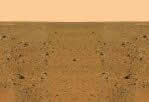| |
Ever
since the 17th century, when Christiaan Huygens first sketched
the face of Mars, people have wondered what the planet is like—and
if it is home to life. To the eyes of early astronomers. Mars
appeared to be a watery world, lush with vegetation. Advanced
civilizations—builders of canals and cities—were thought
to exist on the planet. Today, we know Mars is a cratered, desolate
world. Space probes have mapped all of its barren surface. But
Mars still has plenty of secrets. One of them may yet be life.
|
| SEEING
RED |
From
the first telescopic observations to the latest probe pictures,
our view of Mars has been under constant review. The Dutch astronomer
Christiaan Huygens (1629-93) made the first sketch of the Red
Planet in 1659. He believed that there was life on Mars—
as well as on other planets—and the view through his crude
telescope led him to think that Mars was similar to the Earth.
Huygens could make out dark spots that he mistook for seas, and
assumed the bright regions he observed were fields of ice.
|
Two
centuries later, in 1877, Italian astronomer Giovanni Schiaparelli
(1835-1910) drew the first good maps of Mars. He used a telescope
that could resolve objects down to 50 miles in diameter to fill
in the planet's surface features. The maps—characterized
by dark tracks that Schiaparelli named canali—were controversial:
Some astronomers could see his dark bands, others could not.
|
The
wealthy U.S. businessman Percival Lowell (1855-1916) mistranslated
Schiaparelli's Italian term, and "canali" became "canals."
Excited by what he thought was evidence of extraterrestrial life,
Lowell built himself a telescope to investigate further. High
up in Arizona, Lowell's 24-inch refractor allowed him to make
out Martian surface features just 35 miles across. Despite Lowell7
s conviction, most scientists remained skeptical and dismissed
the idea of water canals—although they all continued to believe
that dark regions on the planet were patches of vegetation. Not
until 1965 were their ideas finally disproved.
|
| Uncovered
Truth |
In
1965, images from NASA's first Martian probe— Mariner 4—gave
Mars its most dramatic costume change since Huygens first sketched
the planet. Disappointingly for some, a dry, rocky world was clearly
visible, with no sign of life. Over the next seven years, three
more spacecraft paid visits. It was the last of these probes—
Mariner 9—that discovered Mars' most spectacular features.
As Mariner 9 orbited the planet, a huge dust storm masked the
surface. When the storm subsided, the tops of volcanoes and the
outline of huge chasms became clear through the orange haze. The
atmospheric pressure of Mars was found to be too low for water
to remain liquid, but these newly discovered channels suggested
that water had once flowed across the surface.
|
In
the mid-1970s, the red surface of Mars became visible from a completely
different angle. Two Viking landers touched down and took images
of the rock-strewn landscape that surrounded them.
|
Though
the Mars Global Surveyor satellite has now photographed surface
objects only five feet across, our view of Mars since the Viking
missions has changed largely through exploration of our own planet.
The discovery of life in hostile environments on Earth has reigned
the idea that Martians could exist in nooks and crannies on the
planet's surface—or perhaps underground. Orbital missions
can tell us little more:
|
Only
painstaking examination at ground level will coax Mars into giving
up its tantalizing secrets.
|
|
|

|
|
|
|

| Red
Face |
| In
1719, Mars' orbit brought the planet so close to Earth that
it appeared unusually bright in the night sky. The vibrancy
of the Red Planet fooled many astronomers, who believed it was
a new, crimson-colored comet. |

| Big
Nose |
| Ancient
Mayan astronomers from Central America, closely studied the
orbit of Mars. In some of their written records, the path of
the planet was portrayed as a long-nosed beast. |
|
|




